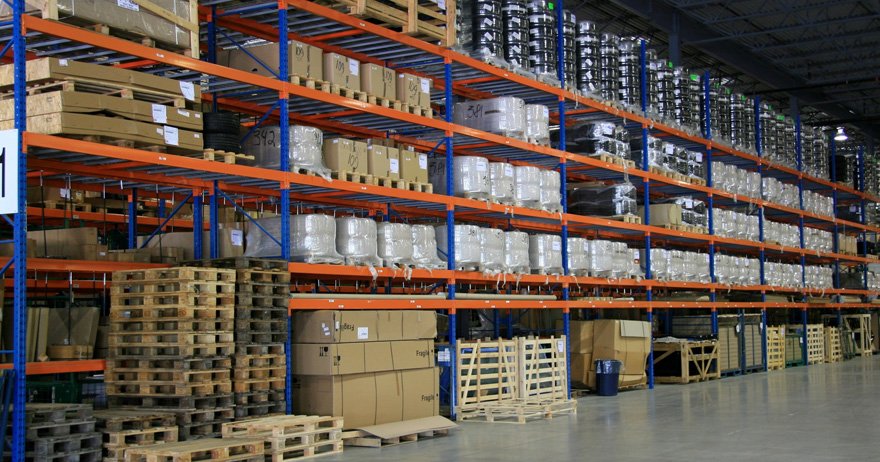Selective Pallet Racking (How Does It Work)?
Selective pallet racking is an innovative storage solution designed to store and retrieve individual pallets within a warehouse. It primarily offers direct access to each pallet, permit for seamless inventory management and retrieval operations.
In this type of storage, the warehouse is predominantly divided into rows of upright frames with horizontal beams that create shelves. The shelves can be managed to accommodate different pallet sizes and heights to enjoy flexibility while storing a wide range of products. The pallets are placed on these shelves and can be easily accessed using forklifts.
Additionally, the defining feature of racking is its selectivity. This means every pallet can be reached and retrieved without rearranging others. This attribute makes selective pallet racking ideal for businesses with a large number of SKUs, as it allows for efficient inventory rotation.
Different Types of Selective Pallet Racking.
- Roll-formed Selective Pallet Racking
- Structural Selective Pallet Racking
- Boltless Selective Pallet Racking
- Drive-In/Drive-Through Racking
- Push-Back Racking
- Pallet Flow Racking
Benefits You Get with Selective Pallet Racking.
If you are an exceptional storage solution for your inventory management and came across this. The following points will blow your mind and convince you to buy such pallet racking for your space.
Effortless Inventory Tracking: Inventory is an indispensable department of each organization and functions rapidly. Since the products are to be loaded, unloaded, and further transferred to another area frequently, there must be a reliable solution that boosts working speed and productivity. For that purpose, selective pallet racking is ideal for enhancing inventory visibility. Each pallet is individually labeled and positioned, which makes it efficient to track and locate items within the racking system.
Inventory Rotation: There are two essential inventory rotation methods, First-In, First-Out (FIFO) & Last-In, First-Out (LIFO). Let’s talk about “FIFO” first; this method mainly ensures that older products are shipped out first, promotes product freshness, and reduces the risk of spoilage or obsolescence.
Whereas LIFO prioritizes using only newly acquired inventory, which can be beneficial when management costs are rising. These rotation methods help optimize inventory usage and ensure better product quality.
Boosted Space: In the warehousing industry, nothing matters but how you utilize and optimize the available space. By utilizing vertical space, such racking maximizes storage capacities. This not only offers room for more inventory but also allows for efficient product organization and listings. This way, the space looks well-arranged, prevents clutter, and reduces the risks of misplacement.
Order Fulfillment: With easy access to pallets on a mass level, employees feel empowered to quickly locate and perform the operations. On the other hand, if reliable storage options back the inventory, there will be more picking errors, and ultimately deadlines will remain unmet. The streamlined order fulfillment process boosts customer satisfaction and establishes a positive reputation.
Accuracy and Control: The systematic arrangement of goods in selective pallet racking enables warehouses and businesses to maintain accurate records. Moreover, operators can easily reconcile physical inventory with recorded quantities by consistently tracking the movement of pallets in and out of the racking system. Believe it or not, it improves work speed. It takes accuracy to the next level by controlling stock levels, reducing discrepancies, and minimizing the risk of stockouts and overstock situations.
Standard design configurations for selective pallet racking layouts.
This is another critical that you just can’t leave without doing anything about it. In order to make them exceptionally useful. You’ll have to determine the recommended aisle widths for proficient movement racking systems, so there are a few key factors that you should consider to keep things in shape.
Let’s break it down.
While using the standard counterbalance forklifts, commonly used in warehouses, in this case, the recommended aisle width should be around 10 to 12 feet for single-deep racking. Maintaining this setting facilitates the crew and the forklifts to maneuver easily and safely between the racks.
If you have double-deep racking, which necessarily means storing pallets two deep, a slightly wider aisle width of around 12 to 14 feet will usually be required. Remember, the longer reach of double-deep forklifts necessitates a bit more space for accessible movements.
In some cases, utilizing the drive-in/drive-through racking, where forklifts enter the racks to deposit pallets, a preferable aisle width of 12 to 15 feet is fair enough. This way, forklifts will safely move in and out of the racks.
Conclusion
By getting to know about the crucial aspects of selecting pallet racking, you can now easily imagine how instrumental role it plays for warehouses and inventory departments. Making a buying decision of selecting pallet racking will not let you down and will take your business to another level.






Recent Comments